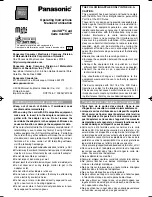
EonStor S12E-R1132-4/G1133-2 Installation and Hardware Reference Manual
detergent. Please use a slightly moistened paper towel or cloth
instead.
2. If it is necessary to transport the subsystem, remove and
repackage all disk drives separately using the original foam
boxes.
3. The subsystem is intended to be rack-mounted. The following
concerns should be heeded when you install the enclosure into a
rack cabinet.
a. The rack cabinet and the associated equipment at the
installation site should be able to maintain an ambient
temperature (around the chassis) lower than 40
°
C or 35
°
C if
a BBU is applied.
b. The openings on the enclosure are for air convection
through the interior of the chassis. DO NOT COVER THE
OPENINGS.
c. Airflow clearance: A minimum of 18 to 20cm clearance is
necessary at the rear side of the chassis. Make sure data
link and console cables are carefully routed so that the
ventilation holes such as the cooling fans’ outlet are not
obstructed.
Ensure proper circulation is available at your installation site
and heated air exhausted from the chassis is brought away.
d. The rack cabinet into which the enclosure is installed must
support over-current protection and must not be overloaded
by the modules installed. Other requirements, such as
ventilation airflow, rack stabilizing features, electrical
earthing, and electrical distribution, must comply with the
technical specifications listed in the documentation or safety
label that came with this product.
e.
Power source and the equipment racks must be grounded.
f.
Consideration should be given to the connection of the
RAID/JBOD subsystem to the supply circuit and the effect
that overloading of circuits might bring.
g. The power source socket outlet should be installed near the
enclosure and should be easily accessible.
4. Place the enclosure on a soft, clean surface before working on it.
Placing the enclosure on a rough surface during servicing may
damage the chassis finish.
5. Do not remove any module or component from its anti-static bag
to prevent static electricity from damaging the electric
2-4
















































